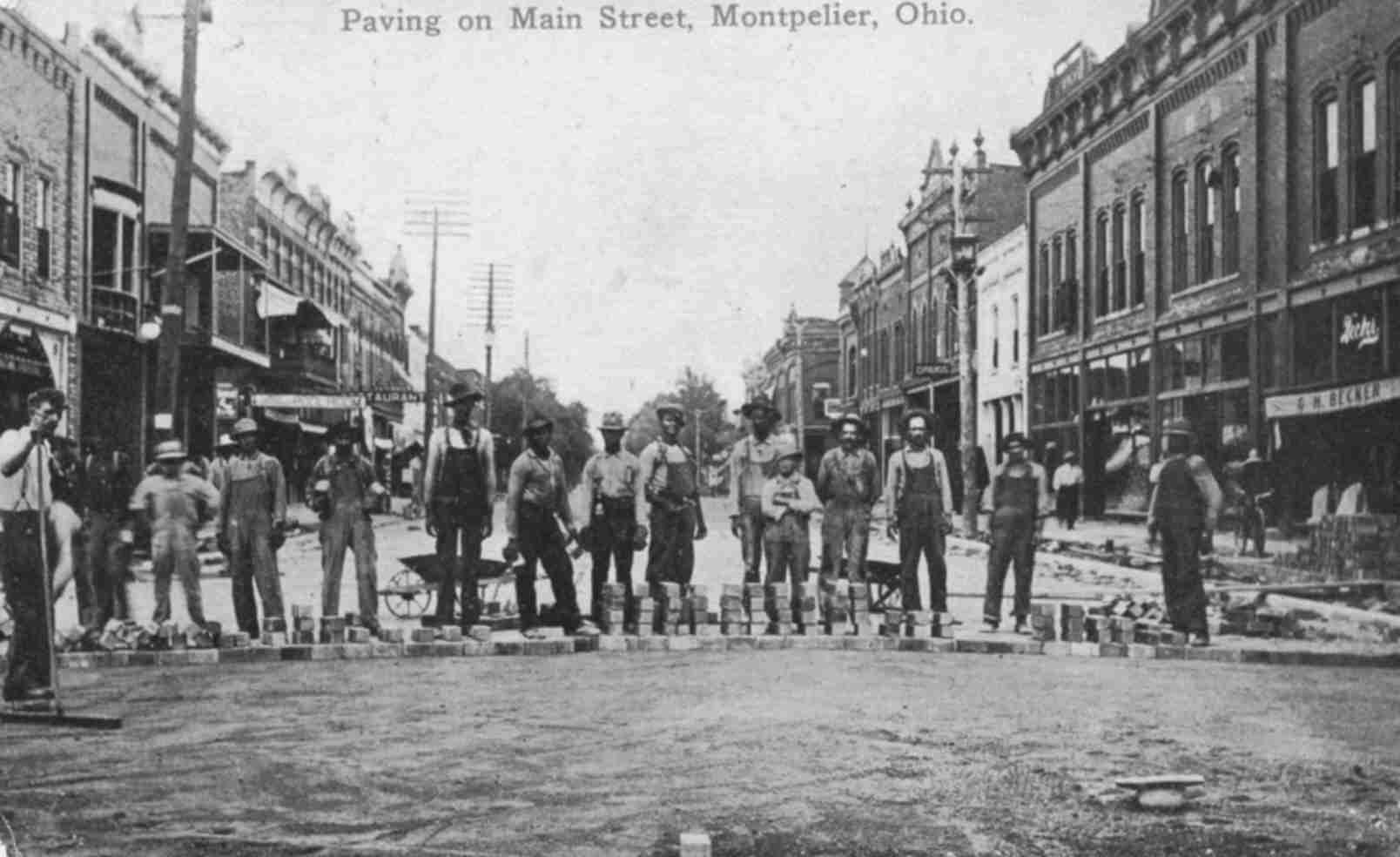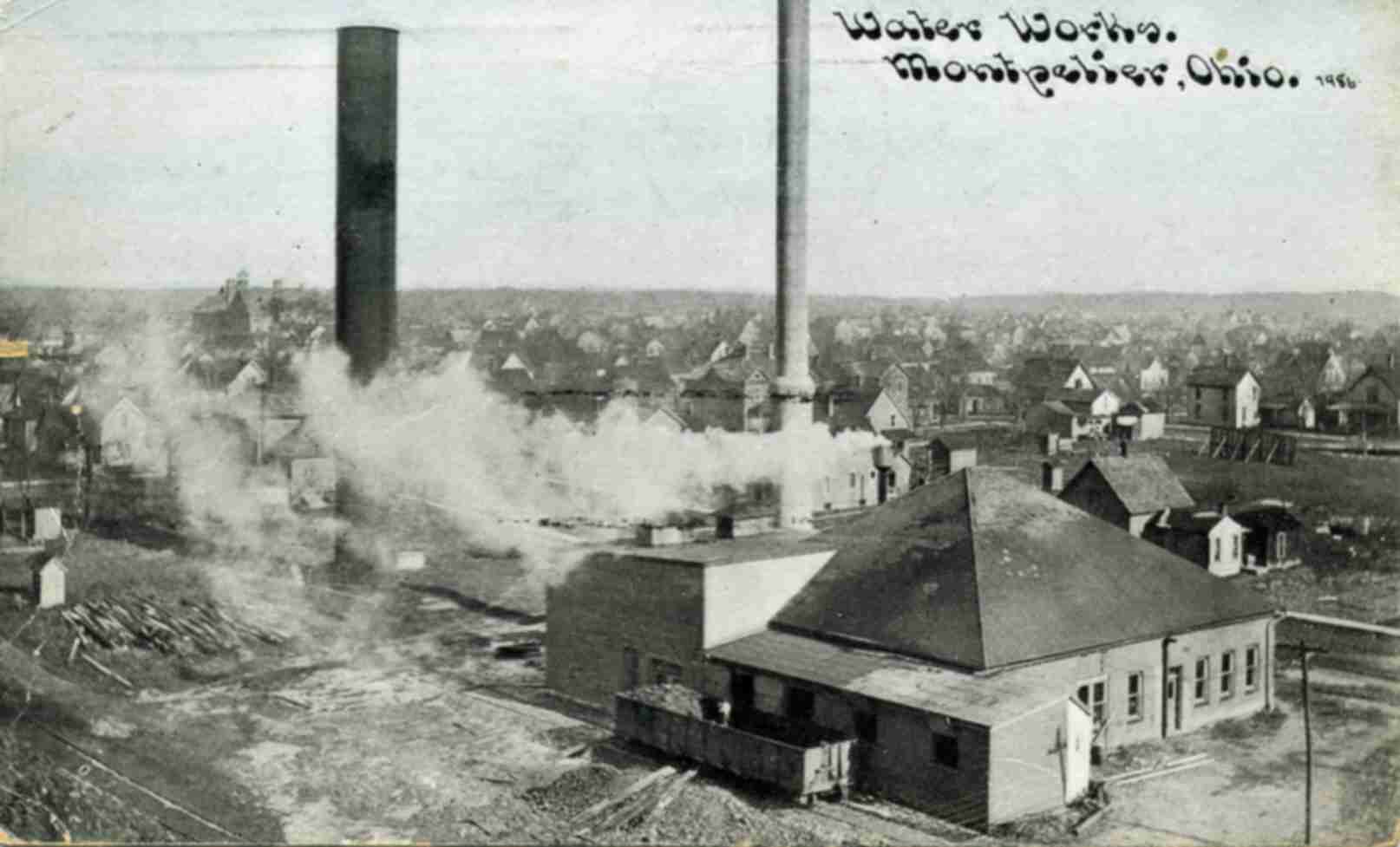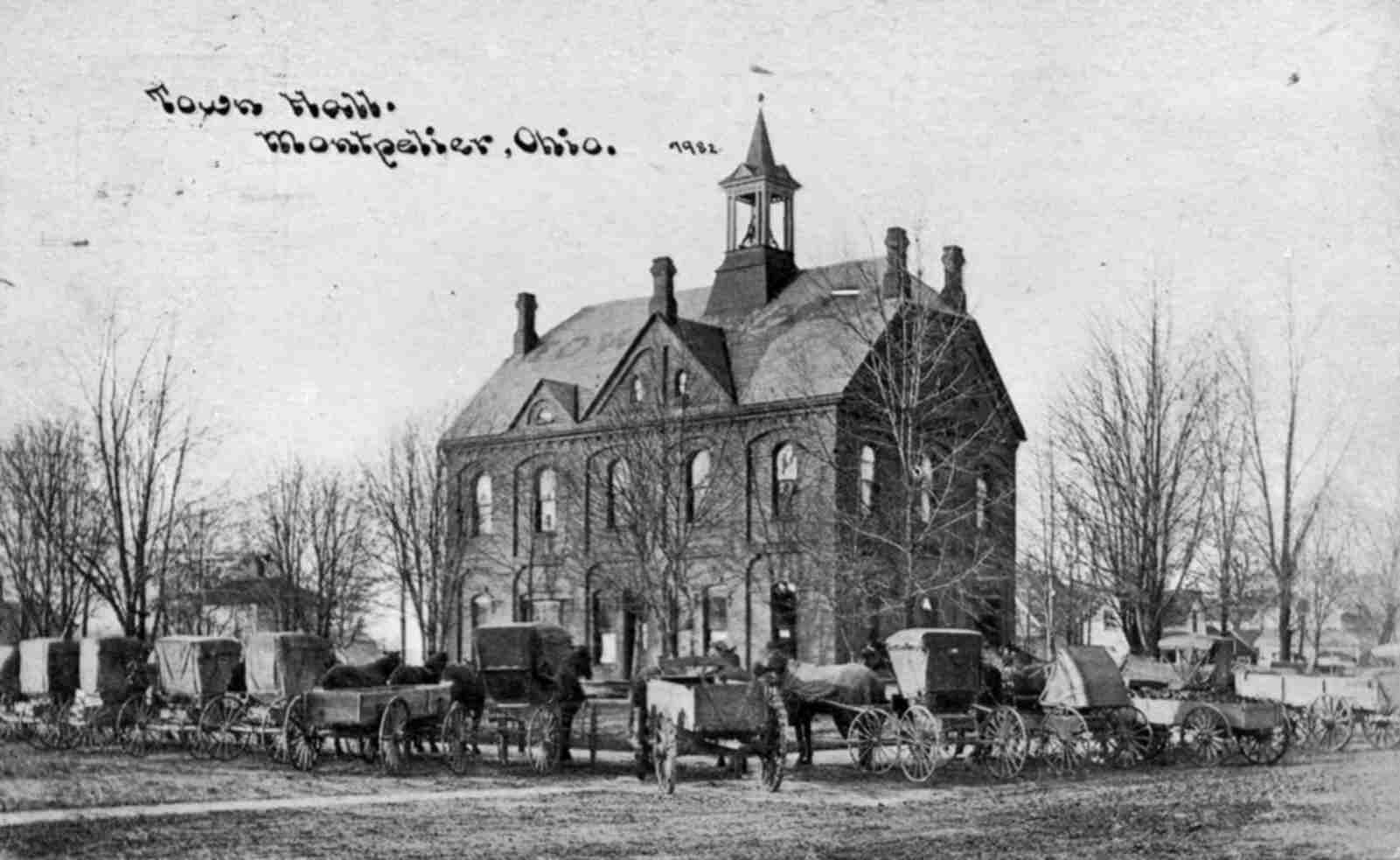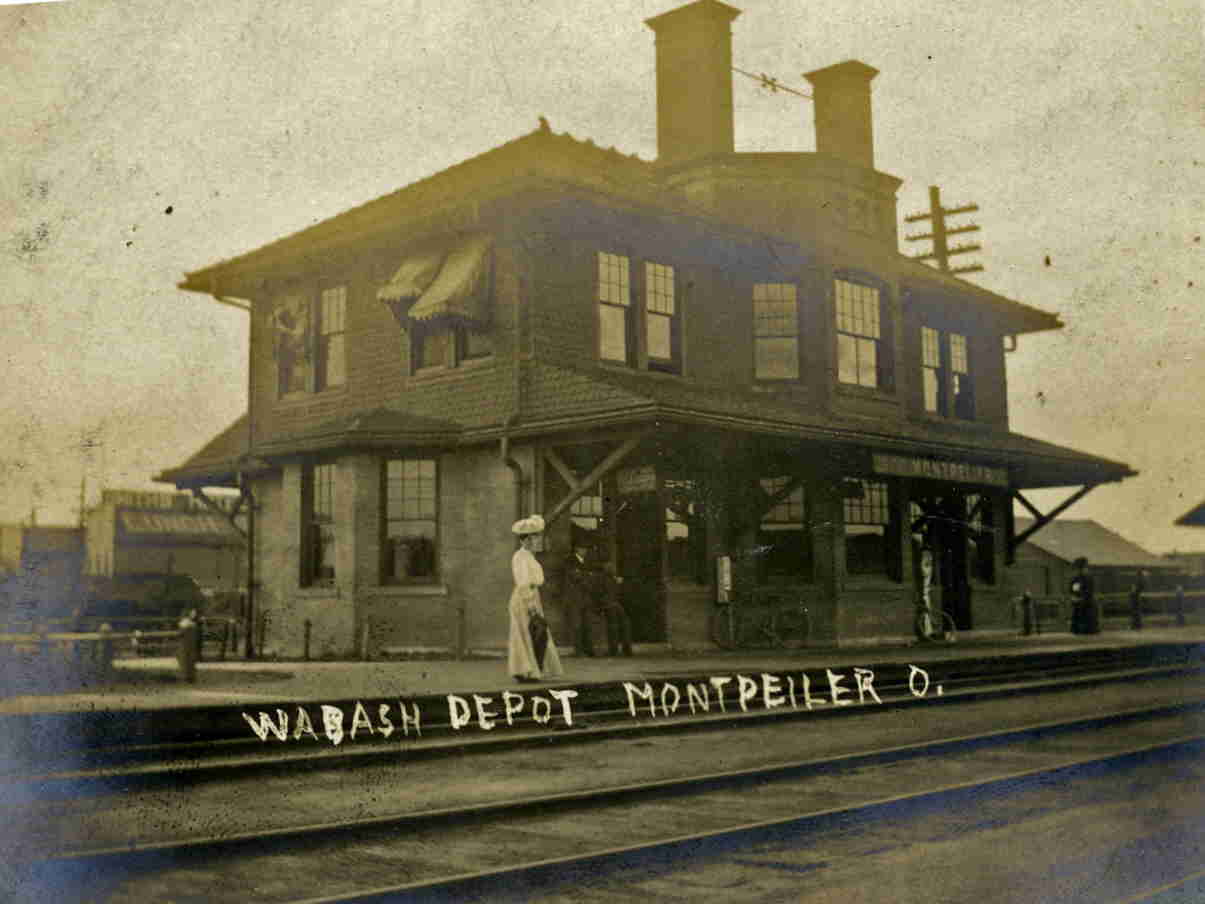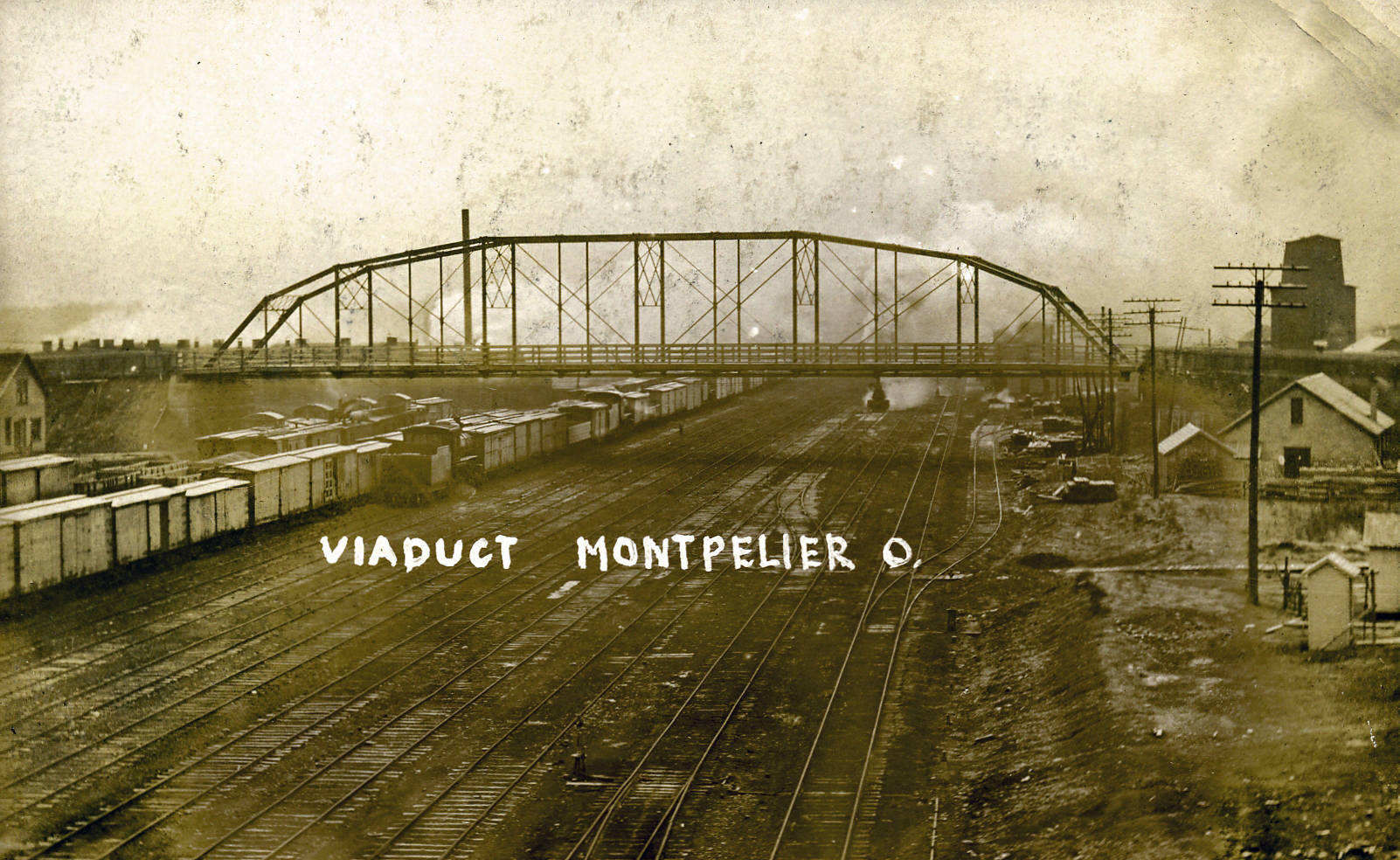History of Montpelier, OH
By Kevin Maynard, Local Historian
The Village of Montpelier has a rich heritage stretching back more than 150 years to its beginnings as a frontier mill site and county seat contender, through its rebirth as a railroad boomtown, and finally its transition to a growing 21st Century community with a more diverse economy.
By 1845, John K. Bryner and Jesse Tucker built a water-powered mill in Section 2 of Superior Township at a bend in the St. Joseph River. On May 25, 1845, Bryner and Tucker had the village of Montpelier, consisting of 41 lots and a public square, surveyed just south of their mill.
Little is known about Tucker and Bryner. John Bryner’s grave has a Mexican War veteran’s marker on it, indicating he left the area soon after the platting of Montpelier to serve in this late 1840s conflict. Following the war, in 1849, Bryner purchased 115.15 acres on the east side of Montpelier, which is now the location of the Williams County fairgrounds.
The 1850 and 1860 Williams County censuses do not list Mr. Bryner. In 1863, his wife Lucynda died and she was buried in Montpelier’s Louden Cemetery, indicating he may have returned to the area around this time. Bryner appears in the 1870 Williams County census as a Pennsylvania native, a farmer by trade, and his age appears to be 63. John Bryner died March 6, 1871, and was buried next to his wife.
Local tradition holds that the surveyor Tucker and Bryner hired to lay out their new town walked from Williams Center to Pulaski, a distance of about eight miles, where Dr. John Paul offered him a ride to the proposed town site. In return for this favor, the surveyor allowed Dr. Paul to name the fledgling village “Montpelier” after the capital of his native state, Vermont. According to the original plat filed in the Williams County recorder’s office, Thomas Ogle performed the surveying work, and the plat was certified by Seth B. Hyatt, county surveyor pro tem.
Why did Tucker and Bryner select this location for their new town? Several possibilities exist. Prior to 1845, Williams County contained two additional rows of townships, making the county’s border about 12 miles further south than today. At that time, Bryan, the county seat, was near Williams County’s geographical center. On March 4, 1845, Defiance County was created, removing the two southernmost rows of townships from Williams County. This placed Bryner and Tucker’s mill near the geographical center of the new, smaller Williams County, and left Bryan about three miles from the county’s south boundary. This turn of events suddenly made their mill site a desirable location for a new town and a good candidate for the county seat.
By 1846, two stores were doing business in Montpelier, and a gristmill and an ashery were constructed about the time the town was surveyed. In December 1846, the Eagle Creek post office, which had been established August 30, 1843, at Robert Ogle’s farm northwest of town, was moved into Conroy Mallory’s store in the village and renamed Montpelier.
In 1850, Montpelier made its first bid to wrestle the county seat from Bryan. Being near Williams County’s geographical center, Montpelier presented a shorter distance for many local residents in the days of difficult travel by horse power or on foot over dirt roads that were impassable much of the year. The Montpelierites’ logical plea to relocate the county seat failed to convince the Ohio Legislature, however, and similar attempts in 1853 and 1857 produced similar results. The “county seat war” between Montpelier and Bryan continued to smolder until 1888 when construction of the existing Williams County courthouse in Bryan finally put the debate to rest.
An 1853 newspaper account states, “Montpelier is a thriving little village with three stores, two groceries, one tavern, one fine gristmill, a (wool) carding machine and various mechanics. We have but little idea of the population, but suppose it to be about 200.”
Shown on an 1864 map of Montpelier are a steam sawmill, gristmill, several stores, a hardware/tinsmith shop, the Empire House hotel, harness shop, blacksmith shop, tannery, school, post office, cabinet and chair maker, wagon wheel shop, United Brethren church, two doctors and a number of homes.
An interesting little-known fact is that on March 28, 1857, Leonard Merry and Samuel S. Bryant had the village of South Montpelier, consisting of 160 lots, surveyed just southeast of Montpelier.
Failing in its attempt to secure the county seat, Montpelier grew very slowly during its first 25 years. In the early 1870s, the Chicago & Canada Southern Railroad was surveyed through Montpelier. This anticipated improvement sparked new growth and optimism in the little community. On March 3, 1874, a petition signed by 51 Montpelier residents, asking for incorporation of the village (and merging the two towns of Montpelier and South Montpelier), was filed at the county auditor’s office. On May 19, 1874, the Williams County commissioners approved incorporation of the village, and in April 1875, Montpelierites elected their first municipal officials.
The Chicago & Canada Southern Railroad failed to materialize, and in 1880, Montpelier was Williams County’s seventh largest village with a population of 405. This all changed with construction of the Detroit, Butler & St. Louis Railroad (later known as the Wabash and today as the Norfolk & Southern) through Montpelier in 1880. The railroad’s arrival spurred phenomenal growth, and in 10 years, Montpelier’s population tripled to 1,203, making it Williams County’s second largest community.
With rapid, inexpensive transportation available via the railroad, a barrel stave factory and an oar factory were established to take advantage of the area’s ash and oak timber resources; many logs were floated down the St. Joseph River to these manufacturing facilities. In 1880, Baldwin Brothers constructed Montpelier’s first brick business building, and numerous other retail businesses soon sprouted up in the boomtown.
In 1885, the Montpelier Union Agriculture Company was organized, and the following year the organization purchased 37.5 acres on the east side of the village from the estate of town founder John K. Bryner and developed a fairgrounds. The Montpelier Fair was held annually for more than 10 years, when the fairgrounds were purchased by the Williams County Agricultural Society, who has conducted the fair ever since. In addition to hosting the Williams County fair annually in September, the Williams County Historical Society’s extensive museum complex and the Williams County Senior Center are located on the fairgrounds.
Montpelier experienced another banner year in 1892, when the Wabash Railroad purchased more than 20 acres to construct a locomotive roundhouse and rail yard in Montpelier. These improvements coincided with the opening of the railroad’s new Chicago to Detroit extension. In 1898, a fine new depot was erected, and the area surrounding it became a virtual beehive of activity.
Montpelier’s first town hall was an old frame schoolhouse that was moved to the public square and divided into two parts—one side serving as a classroom and meeting room, the other converted into a “calaboose” or jail. With the town’s continued good fortunes, bonds were issued and a fine new brick town hall was constructed in 1892. This beautiful historic building, with additions and alterations, celebrated its 100th birthday in 1992 and still serves as the headquarters of local government.
On April 1, 1895, Montpelier voters approved issuing bonds to finance construction of a municipal electric and water system. An electric and water plant building was completed by year’s end northeast of the depot, bringing Montpelier into the modern age of electricity and providing local homes and businesses with improved fire protection. Montpelier’s municipal utilities continue to offer the community outstanding rates and service.
Montpelier’s first newspaper appeared in the mid-1850s and was followed by a number of other local publications whose histories were detailed by the late Paul Van Gundy in the 1978 Williams County history. The first issue of the Montpelier Enterprise – still serving the area today as the Leader-Enterprise – was published on September 20, 1880.
The Wabash Railroad remained a dominant force in the community for many years. In 1901, the Wabash rail extension from Montpelier to Toledo was completed; in 1907, the railroad moved its shops from Ashley, Ind., to Montpelier. In 1917, the railroad’s division offices were relocated to Montpelier. A 1936 newspaper article reported that the Wabash employed 400 people locally, with an office staff of 20. The railroad was so closely identified with the town’s prosperity that the phase “As the Wabash goes, so goes Montpelier” was coined, and the high school teams became known as the “Montpelier Locomotives.”
Twentieth century transportation improvements caused a decline in the railroad’s use and importance. In 1971, the Wabash discontinued passenger service through Montpelier. The division offices were moved to Fort Wayne and in February 1981, the historic depot—once a focal point of activity in Montpelier—was razed after standing vacant for about two years.
The town’s metamorphosis from a railroad town to a more diversified economy was not always easy, but the citizens’ hard work and determination have paid good dividends. Recent improvements such as a fine new school building, municipal water treatment plant, industrial park expansion and renovation of the downtown business district make Montpelier’s future look very promising.

